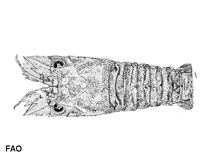| Family: |
Scyllaridae (slipper lobsters) |
| Max. size: |
4.2 cm TL (male/unsexed); 6.8 cm TL (female) |
| Environment: |
benthic; marine; depth range 0 - 282 m |
| Distribution: |
Indo-West Pacific. |
| Diagnosis: |
The teeth in the median line of the carapace low obscure: the rostral tooth is usually reduced to a mere tubercle, the pregastric tooth is distinct, but low, the gastric tooth is absent; the cardiac tooth (behind the cervical groove) is replaced by 2 blunt and flattened submedian tubercles. The region between the post-rostral and branchial carinae shows few tubercles and rather large smooth areas. Abdomen without median carina, the median area of the somites is low and flat. The exposed part of the abdominal somites shows an arborescent pattern of narrow grooves. Somite 1 has a complete transverse groove behind which there are numerous parallel oblique grooves, which in the middle of the segment form a triangular figure. Fourth segment of the antenna with a single straight and obliquely directed median carina; no additional carinae or tubercles on the dorsal surface. Outer margin of the segment with two distinct sharp teeth, inner margin with a large single sharp tooth (apical tooth of segment not included). Thoracic sternum with the anterior margin straight and transverse, with a very narrow median incision. The anterior margin forms a broad ridge behind which there is a sunken triangular area. No median tubercles on the sternites. Dactylus of pereiopods 1,2,4 and 5 without hairy fringes. Colour: the body is reddish brown. Most conspiucuous and characteristic are two large dark spots on the first abdominal somite, one on each side slightly above the base of the pleuron. The legs are pale with a few dark bands (Ref. 252). |
| Biology: |
It has lengths of 4.2 cm (males) and 5.8 cm (females), maximum total body length; 0.4 to 1.5 cm (males) and 0.5 to 2 cm (females & ovigerous females), carapace length (Ref. 4). Maximum size for females 6.8 cm in Ref. 89665. It is found on a soft substrate (mud, sandy mud, muddy sand, sand, coralline algae, etc.) (Ref. 4). |
| IUCN Red List Status: |
(LC); Date assessed: 03 December 2009 Ref. 123251)
|
| Threat to humans: |
|
| Country info: |
|
Source and more info: www.sealifebase.org. For personal, classroom, and other internal use only. Not for publication.

